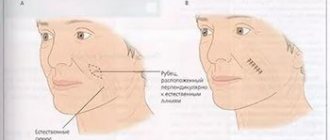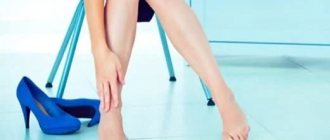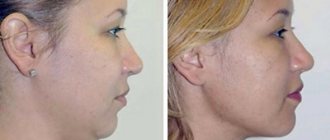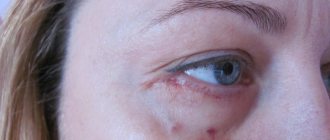What are rosacea and rosacea?
Rosacea and rosacea are types of vascular pathologies that are characterized by the appearance of dilated blood vessels. As a result, the skin acquires a reddish tint.
Rosacea is a chronic skin lesion that occurs with rashes and redness. That is why the pathology received a name that speaks for itself - pink acne.
Today, there is no exact explanation for why rosacea occurs. The disease can be triggered by diet, hormone imbalance, or predisposition. Alcohol consumption, stress, hypothermia, allergies - any factors that provoke vasodilation - contribute to the occurrence of rosacea.
Cuperosis is an expansion of small capillaries that causes redness of the skin. Due to expansion, the walls of blood vessels become thinner and lose their elasticity. The vessels fill with blood, giving the skin a reddish tint. If the disease progresses, stable networks of blood vessels form on the skin, covering large areas of the face.
Cuperosis can be attributed to a physiological feature that requires treatment. Prolonged manifestations of rosacea lead to a lack of oxygen and nutritional components in skin cells. The skin loses water, becomes dry, its color deteriorates, and aging processes begin prematurely.
What do rosacea and rosacea look like? Spider veins and spider veins appear on the skin. They often occur in the T-zone. Those with sensitive, fair skin are most susceptible to vascular pathologies.
2.REMOVING VASCULAR LEGS
Our clinic specialists use the Fotona SP Dynamis laser, a neodymium laser with a wavelength of 1064 nm, to remove spider veins (telangiectasia) on the legs. Such laser characteristics provide: firstly, effective coagulation of blood vessels in the legs of both venous and arterial origin; secondly, complete safety for the skin surface. Due to the selectivity of the neodymium laser, superficial visible capillaries are sealed without damaging surrounding tissues.
Advantages of FOTONA neodymium laser
- There is no rehabilitation period.
- Possibility of selecting strictly individual impact parameters.
- Controlled point selectivity of exposure along the entire length of the visible capillary.
What are the differences between rosacea and rosacea?
What rosacea and rosacea are is easy to understand. But the diseases are difficult to distinguish from each other without qualified help. Couperosis or rosacea can be determined by symptoms. The main difference is that rosacea is never accompanied by purulent inflammation, the skin is smooth, without compactions.
Couperosis and rosacea on the face have differences in symptoms. With rosacea, small and large blood vessels are affected, causing the skin to acquire a reddish tint. In rare cases, rosacea is accompanied by a fiery skin color - there is a feeling that the skin is burning, but in fact there are no painful symptoms.
Unlike rosacea, rosacea is accompanied by painful sensations. In addition to redness, purulent inflammation and uneven relief are formed. The difference between rosacea and rosacea on the face is itching.
The difference between rosacea and rosacea is the course of the disease. Rosacea occurs in several stages:
- Erythematous. Temporary redness of the skin occurs. Subsequently, the redness becomes persistent.
- Papulopustular. In the area of redness, rashes filled with reddish liquid appear. They arise due to metabolic disorders in the skin and vasodilation. Blood seeps into the surrounding tissues, coloring them in a characteristic color.
- Phimosis. Densified nodules and plaques form on the skin.
- Rhinoform. Accompanied by an increase in the size of the nose. This stage is typical only for men.
Symptoms
Although this disease can affect any part of the skin, it most often manifests itself on the face - on the wings of the nose, cheeks and chin. This is due to the fact that in these areas the skin is thin and elastic.
This type of vascular network does not hurt, and there is rarely a feeling of itching or burning. It happens that after the appearance of such stars, the process slows down and stops - if you do not injure the skin and care for it properly, this does not cause any discomfort to the patient (or only aesthetic discomfort). But in some cases, the disease progresses and becomes more serious: the affected areas of the skin begin to turn blue, the skin or limbs (if rosacea is on the legs) swell, and inflammation begins.
Even if physically the symptoms of rosacea do not bother you, but it has appeared recently, you need to consult a dermatologist: if possible, find out the reasons for the deviation and understand whether there is any additional danger in it.
How is rosacea diagnosed?
Regardless of the nature of the disease (rosacea, demodicosis, rosacea), treatment is preceded by diagnosis. A cosmetologist will determine whether the patient has rosacea or rosacea. An examination, blood test, and in some cases, scrapings of the affected skin areas will be required. If necessary, the doctor will prescribe an ultrasound of the internal organs to rule out diseases that can provoke skin reactions.
The task of a cosmetologist is not only to eliminate the external manifestations of rosacea on the skin, but also to establish the cause of the disease. To do this, it is necessary to examine the state of the gastrointestinal tract and endocrine system - to exclude gastritis, colitis, hormone imbalance, etc.
Why spider veins appear on the face: the main causes and treatment methods
Cosmetologists distinguish three main types of rosacea:
- Venous
- Arterial
- Capillary
Most often, this problem is faced by women with thin and most sensitive skin, because they suffer the most from temperature changes, exposure to cosmetics and sunlight.
However, it is important to understand that a network of spider veins can cause anxiety not only for older ladies, but also for very young ladies. Couperosis can even occur in children and adolescents, especially if it is passed on to them at the genetic level.
Here are the main signs of its manifestation:
- The appearance of redness on the skin that does not have clear boundaries. Most often they form in the areas of the forehead, wings of the nose, and chin.
- Itching that causes discomfort after washing, walking in the fresh air and or applying cosmetics.
- Burning and tingling sensations.
- A network of blood vessels that becomes noticeable on the surface of the face.
All these signs characterize the initial stage of rosacea.
A neglected situation is characterized by such phenomena as:
- Formation of relief seals.
- The appearance of pinkish acne.
- Dark red bumps in the affected area.
What should you not eat if you have rosacea?
Rosacea and rosacea on the face are diseases that require a comprehensive approach to treatment. First of all, this concerns nutrition. To get rid of rosacea, you need to exclude dangerous and harmful foods from your diet:
- Sweet and floury. They contain sugars that cause inflammation
- Dairy products. Progesterone, which dairy products are rich in, enhances the functions of the sebaceous glands - there are more purulent inflammations on the skin.
- Alcohol. It has been scientifically proven that alcoholic drinks themselves do not cause rosacea, but aggravate the course of the disease. Alcohol dilates blood vessels and causes an additional blush on the face.
- Products containing caffeine (tea and coffee). They stimulate the production of the hormone cortisol, which triggers stress. Stressful situations often lead to inflammation on the skin.
- Canned, pickled, salted, fried and spicy foods. They lead to acne on the skin, dilate blood vessels, and weaken the immune system.
- Citrus and sweet fruits. Causes skin inflammation.
Diagnostics
To determine rosacea on the body, a dermatologist does not need much research. But it is important for patients to understand that they cannot do this on their own; it is necessary to differentiate this condition from others that may be more dangerous.
For diagnostics the following are used:
- Examination, history taking and dermatoscopy.
- General urine and blood tests, biochemical blood tests, as well as tests for certain types of hormones.
- Ultrasound of the thyroid gland and abdominal organs (optional).
If a specialist suspects hidden diseases, this list may expand.
Can rosacea be cured permanently?
Regardless of whether it is telangiectasia, rosacea or rosacea, treatment should be comprehensive. The peculiarity of rosacea is that despite external signs, the causes are hidden deep in the body. And to get rid of rosacea forever, you need to identify and eliminate the cause of the disease.
Treatment of rosacea and rosacea is carried out in several directions. As a rule, an endocrinologist and cosmetologist develop a comprehensive treatment plan that is aimed at quickly eliminating the external manifestations of the disease and deeply treating the causes of rosacea.
Treatment of rosacea and rosacea consists of the following steps:
- Proper skin care. Careful hygiene, selection of cosmetics, daily use of cream with SPF protection. Acid peels, products containing alcohol, and rough scrubs are contraindicated for rosacea.
- Therapeutic treatment. Based on the use of antibacterial and antiseptic agents that eliminate the causes and consequences of acne.
- Drug treatment. Depending on the indications, the patient may be prescribed medications, hormonal drugs, etc.
- Hardware treatment. Elimination of spider veins using hardware methods.
Why are capillaries damaged?
There are a number of reasons for this, which can be divided into external and internal.
Doctors consider external threats to include:
- Alcohol and cigarette abuse
- The predominance of hot, hot, spicy foods in the diet
- Hot coffee and tea more than 2 cups per day
- Poor quality care and use of “bad” decorative cosmetics
- Frequent and prolonged exposure to the sun, especially without the use of high SPF protection products
- Visiting baths, saunas
Among the internal risk factors are:
- Autoimmune spectrum diseases
- Pathologies of the digestive system
- Atherosclerosis and other vascular diseases
- Rosacea
- Hormonal imbalance
It is important to understand that people with fair, sensitive, irritation-prone skin are more likely to suffer from rosacea.
What cosmetic procedures can be done for rosacea?
When treating rosacea and rosacea on the face, you cannot do without cosmetic procedures. But not all of them are allowed for vascular pathologies.
The following help to effectively get rid of rosacea and rosacea:
- Phototherapy. Pulsed light affects pathological tissues. The targets of the rays are microorganisms and altered capillaries. Under the influence of photo flashes, old collagen fibers are destroyed and the production of new ones is started. The main feature of phototherapy is the ability to glue blood vessels. The rays heat the vessel to 60 degrees, which provokes blood clotting and the vessels become empty.
- Plasma therapy. The procedure is based on the use of autogenous plasma. Plasma therapy triggers skin cell restoration processes, normalizes metabolism, and saturates the skin with useful substances. In the dermis, collagen synthesis is enhanced and inflammation processes are reduced.
Recommendations after the procedure
After the procedure, swelling and redness of the skin may persist for 1-3 days.
To consolidate the result and speed up recovery, it is recommended:
- Refrain from sunbathing, visiting bathhouses, saunas and solariums for a month
- Avoid sudden temperature changes
- Use sunscreen and nourishing cream selected by a dermatologist according to your skin type
- If possible , refrain from wearing decorative cosmetics for 1-3 days after the procedure.
- Phototherapy eliminates the aesthetic consequences of vascular problems; to strengthen capillaries and prevent recurrent problems, it is recommended to use vascular strengthening products
Treatment of rosacea with M22 is an effective way to achieve beautiful and healthy skin!
It is recommended to delay phototherapy if:
- Pregnancy and breastfeeding
- Having a pronounced and intense tan
- Some skin diseases: psoriasis, dermatitis
- Acute infections, including skin infections
- A course of use of drugs that increase sensitivity to sunlight
- Eye diseases
- Presence of pacemakers or other metal-containing structures
Phototherapy with the M22 device helps to get rid of even deeply located vessels, while the procedure is completely safe, approved by the FDA and used by leading cosmetologists in many countries around the world.
The M22 device does not disrupt the pH balance of the skin and the protective lipid layer of the dermis, and rehabilitation after the procedure takes no more than a couple of days.
The M22 device allows for an individual approach - the doctor can select the type of platform module and light filter for each patient in accordance with his needs.
Can rosacea be treated with laser?
Couperosis and rosacea can be eliminated with laser. Vascular networks are cauterized with laser beams. The method is effective at different stages of the disease - both at the initial and in advanced cases.
Laser beams quickly and permanently eliminate redness and spider veins from the skin surface. The number of sessions depends on the stage of rosacea and rosacea.
Laser removal of rosacea and rosacea is an effective method for spider veins. The procedure allows you to get a pronounced result and does not require a long recovery period. The effect of the procedure lasts for several years.
Phototherapy
This procedure is very similar in principle to laser therapy. It will help you forget about the problem of rosacea forever, and in a fairly short time, without causing any discomfort. Another advantage of this method is the fact that, together with a network of capillaries, you can say goodbye to age spots, improve complexion and skin elasticity.
The full course of procedures consists of 5-7 sessions lasting about half an hour.
However, not everything is so rosy. We must not forget the side effects, such as:
- The appearance of white spots.
- Allergic reactions.
- Edema.
It is worth noting the high cost of such a technique. It is important to find a good clinic and a professional cosmetologist, therefore, when thinking about how and where to remove spider veins on the face, study the reviews of patients who have already undergone this procedure.
Is it possible to do a chemical peel for rosacea?
Couperosis or rosacea on the face are diseases that require careful skin care. Aggressive chemical peels can only worsen the disease. Unprofessional acid peeling provokes persistent redness - the skin takes a long time to heal after the procedure. An unskilled approach to therapy and an illiterate selection of home remedies will aggravate the course of the disease. A cosmetologist knows how to treat rosacea and rosacea on the face.
For rosacea and rosacea, only delicate peels are indicated (for example, using mandelic or lactic acid). Antioxidant monopilings are prescribed for the erythematous form of rosacea. Superficial almond peeling does not cause peeling or burning.
For the pustular form, combinations of azelaic and lactic acid can be used. They inhibit the production of reactive oxygen species and regulate the formation of secretion from the skin glands. The doctor selects the acid composition for peeling individually depending on the nature and course of the disease.
Capillary mesh on the face: tolerate or remove?
You probably know and have seen where such a mesh pattern on the face is most pronounced. Most often, patients come to us who have thin red lines of blood vessels appearing on their face. The cheeks, nose, and sometimes the chin or forehead are especially affected. This not only complicates the health situation and makes you think about the state of the cardiovascular system, but is also an aesthetic problem.
When thinking about removing capillary mesh on your face, you must understand that procedures and doctor’s advice alone will not be enough. It is important to minimize the impact of internal and external irritants to help your skin recover, strengthen and glow.
Modern clinics offer various ways to remove venous mesh on the face:
- photocoagulation (laser exposure);
- electrocoagulation (exposure to electric shock);
- phototherapy (there are different techniques);
- ozone therapy (exposure to ozone gas)
- sclerotherapy (introduction of special compounds directly into the vessels);
- radio wave surgery.
All methods and techniques have their own specifics. If you decide to remove the vascular network on your face, you should choose them together with a qualified specialist, preferably one who has a medical education and experience in working with similar cases. Don't be afraid to ask questions, because we are talking about your health and appearance.
In our clinic, all cosmetologists are educated in the medical field and know how to select the right treatment for spider veins. We practice laser removal. The method of using a laser to solve the problem of vascular pattern is called effective, powerful and safe.
What is rosacea and how to get rid of it?
Cuperosis can be either an independent manifestation of changes in the skin or a sign of serious diseases. Cuperosis occurs in several stages:
- Rapid redness for no obvious reason. After a while, the redness disappears without consequences - the vessels are still elastic to restore their original state.
- A characteristic pattern of blood vessels appears on the skin. This is a sign that the blood vessels cannot return to normal.
- Chronic blood circulation disorders and lack of nutrition of skin cells.
A cosmetologist knows how to treat rosacea and rosacea. You can get rid of skin pathologies in a comprehensive manner by identifying the cause of the disease. If rosacea is caused by a disease of the internal organs, they need to be treated first. The use of only external agents will eliminate the manifestations of rosacea, but will not protect against the appearance of new spider veins. A combination of therapy methods that complement each other will achieve lasting results.
What products to choose for complete care?
We have selected products that will fit perfectly into the daily routine of skin with rosacea.
Cleansing
Sioris washing gel based on plant extracts gently cleanses the skin of impurities and moisturizes.
The composition includes extracts of pomelo, orange, black willow bark, geranium and chamomile oil.
The product does not cause irritation and is ideal for sensitive skin!
Toning
Soothing toner with centella from the organic brand Purito perfectly moisturizes, tones and relieves redness. The composition of the toner helps restore the lipid barrier of the skin and reduce skin sensitivity to irritating factors.
The product, in addition to the main component - centella asiatica, contains witch hazel extract, panthenol, allantoin and hyaluronic acid.
Stage aimed at solving specific problems
Serum with a stable form of vitamin C from Cu Skin is an ideal solution for skin with rosacea . This product helps strengthen the walls of blood vessels, stimulate collagen synthesis, intensely moisturize and relieve inflammation.
Vitamin C is the best antioxidant for the skin, which gives it radiance and evens out its tone!
The product contains camellia extract, forest orchid, hyaluronic acid and betaine.
What should you not do if you have rosacea?
Rosacea and rosacea, although not the same thing, have similar limitations. If you have rosacea, you should avoid the following:
- baths and saunas
- artificial tanning in a solarium
- traumatic facial cleansing
- laser resurfacing
- cosmetics with acids and alcohol
- scrubs and peelings with hard particles
- thermal masks
- contrasting washes
Acne, rosacea and rosacea should be treated by eliminating harmful foods from the diet:
- alcohol and carbonated drinks
- baked goods, sweets and cakes
- all types of red meat
- canned, spicy and salty foods
results
Contraindications:
fresh tan vitiligo inflammation epileptic seizures use of antidepressants diabetes mellitus
dermatological diseases oncology keloid scars pregnancy period lactation
results
After the procedure, the patient can immediately return to his business; there is no rehabilitation. There are no restrictions on sports activities. You can sunbathe in the sun or in a solarium after 7-10 days.
The result appears after the first session with mild rosacea. Sometimes up to 4 sessions may be required. A repeat procedure is carried out a month later.
Above are photos of our patients before and after laser removal of rosacea.
Features of blood supply in the facial area.
Features of blood supply in the facial area.
The maxillofacial area is supplied with blood by the branches of the external carotid artery, which form a group of anterior, middle and posterior branches.
The anterior group includes the thyroid, lingual and facial arteries.
The middle group consists of the ascending pharyngeal artery, superficial temporal and maxillary arteries.
The posterior group is formed by the sternocleidomastoid branch, the occipital artery and the posterior auricular artery.
Branches of the external carotid artery.
1 – superficial temporal artery; 2 – occipital artery;
3 – maxillary artery; 4 – external carotid artery;
5 – ascending pharyngeal artery; 6 – internal carotid artery;
7 – muscle that lifts the scapula; 8 – trapezius muscle;
9 – suprascapular artery; 10 – brachial plexus;
11 – thyrocervical trunk; 12 - common carotid artery;
13 – superior thyroid artery; 14 – lingual artery; 15 – facial artery;
16 – anterior belly of the digastric muscle; 17 – buccal muscle; 18 – middle meningeal artery.
The outflow of venous blood from the organs and tissues of the maxillofacial region is carried out into the internal jugular vein, which receives blood from the facial vein, pterygoid venous plexus, lingual, thyroid and mandibular veins.
Lymph from the head and neck area collects in the jugular lymphatic trunks, which also receives lymph from the mastoid, parotid, submandibular, peripharyngeal and mental regional nodes.
Regulation of blood circulation in the vascular system of the maxillofacial region is carried out by the nervous and humoral pathways. In addition, the vessels have their own basal tone (myogenic regulatory mechanisms).
The vasomotor center of the medulla oblongata sends impulses along nerve fibers through the cervical sympathetic nodes to the vessels of the maxillofacial region.
The vessels of the face form an abundant network with well-developed anastomoses, so wounds on the face heal quickly.
When carrying out all procedures , you should be as careful as possible to avoid intra-arterial and intravenous administration of the drug.
It is safe to inject the drug into the periosteum using cannulas, which are less dangerous than needles.
DANGEROUS AREAS FOR INSTRUCTION OF FILLERS.
Projection of the bony openings of the facial part of the skull.
- supraorbitalis (supraorbital foramen) - the place of exit of the supraorbital SNP - the place of intersection of the upper bony edge of the orbit with a vertical line drawn through the medial edge of the iris. SNP is covered by m. orbicularis oculi, direction of movement - up under m. corrugator and m. frontalis.
- infraorbitalis (infraorbital foramen) – the exit point of the infraorbital SNP – the intersection of a point 1 cm below the lower bony edge of the orbit with a vertical line drawn through the medial edge of the iris. SNP is covered by m. orbicularis oculi and m. levator labii superioris direction of movement is downward and medial.
- mentalis (mental foramen) – the place of exit of the mental SNP – the place of intersection of the mid-height of the lower jaw at the intersection with a vertical line drawn through the medial edge of the iris. SNP is covered by m. depressor labii inferioris, the direction of travel is upward and medial.
Deep injections into the projection of the neurovascular bundles can lead to compression of blood vessels and disruption of blood supply, can be painful and cause changes in skin sensitivity.
The nasal region contains many terminal arteries.
When correcting this area, it is important to take special care, because the terminal branches of the arteries pass there, and the injection of Hyaluronic acid can have catastrophic consequences.
With increasing scientific evidence regarding embolization of small facial arteries following filler injections, nasal procedures should only be performed using cannulas.
From the ophthalmic artery Dorsal nasal artery Vessels of the angle of the nose Lateral nasal artery
From the external carotid artery to the columella artery.
Interbrow area.
When injecting fillers into the glabella area, local necrosis may develop due to the small number of vessels in this area.
In the area delimited by the points of fixation to the bone m. orbicularis oculi from the sides, m. corrugator supercilii above and m. procerus from below, the distribution of the filler is difficult (especially drugs with high viscosity HA), creating a high local pressure of the drug on the tissues and vessels.
Temporal and periorbital regions.
The superficial temporal (sentinel) vein is located in the temporal region behind the artery of the same name and follows its course. Crossing the temporal region 1-1.5 cm above the zygomatic arch, the vein in the layer of subcutaneous fatty tissue is directed to the auricle.
At the medial edge of the orbit, the angular vein is located superficially ; it communicates through the veins of the orbit with the cavernous sinus of the dura mater.
Careless injection of filler into the lumen of the vein or its excessive amount can lead to thrombosis, hematoma or later complications of an infectious nature.
temporales (temporal branch) of the facial nerve in the temporal region lies under the SMAS and goes to the tail of the eyebrow.
The place of its surface occurrence is located in the projection of a triangle, the apex of which is located 2 cm above the end of the eyebrow, and the base is along the lower zygomatic arch.
The parotid salivary gland is in the shape of an inverted triangle with its base on the zygomatic arch and its apex in the area of the angle of the mandible.
The duct of the parotid salivary gland lies below and parallel to the zygomatic arch under the SMAS layer, it horizontally crosses m. masseter and, entering the buccal muscle, appears in the vestibule of the oral cavity.
Damage to the duct leads to the development of chronic local inflammation of the adjacent soft tissues.
transversa facies (transverse artery of the face) is located in the zygomatic region. Parallel and superior to the parotid duct. The vessel supplies blood to the soft tissues of the area, including the skin and subcutaneous tissue through perforator vessels; the permanent perforator is located in the middle of the distance between the wing of the nose and the ear canal or 3 cm medially and 3.5 below the orbital edge.
When performing procedures with a cannula in the zygomatic region, damage to the permanent perforator should be avoided. transversa facies.
marginalis mandibulae (marginal branch of the mandible) of the facial nerve is located under the SMAS and descends first behind the branch and angle of the mandible and, not reaching the posterior edge of the m. depressor anguli oris, extends onto the face, located at this point on the bone.
Deep bone injections in this area should be carried out with caution, because this branch innervates the muscles of the lower lip and part of the subcutaneous muscle of the neck.
Educational phone numbers : 8-812-248-99-34, 8-812-248-99-38, 8-812-243-91-63, 8-929-105-68-44
Application for ordering products here
Seminar schedule here
Our specialists
Katerina Kuznetsova
Directions:
care procedures; hardware facial cleansing; mechanical facial cleansing; peelings; non-surgical lift; hardware figure correction; biostimulation; laser hair removal; biorevitalization; mesotherapy and more
Sign up via WhatsApp Sign up via Telegram
Yulia Apaeva
Directions:
non-surgical lift; figure correction; Ultrasound SMAS-lifting; phototherapy of face and body; laser cosmetology; botulinum therapy; SPRS therapy; contour plastic; plasma lifting; mesotherapy and more
Sign up via WhatsApp Sign up via Telegram
All specialists











